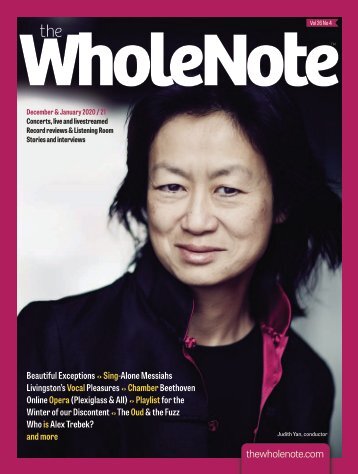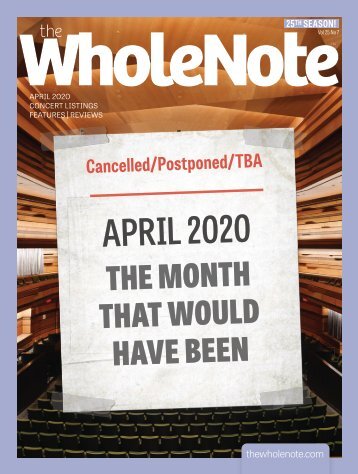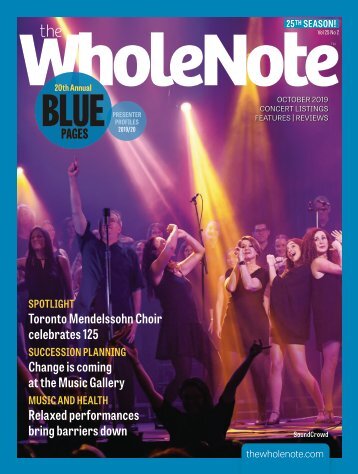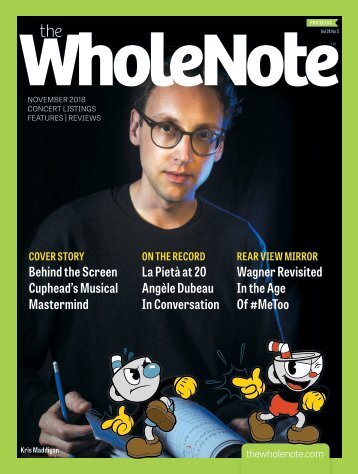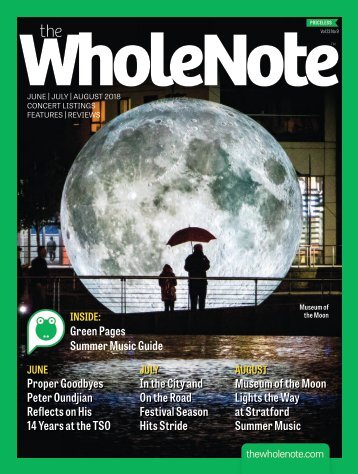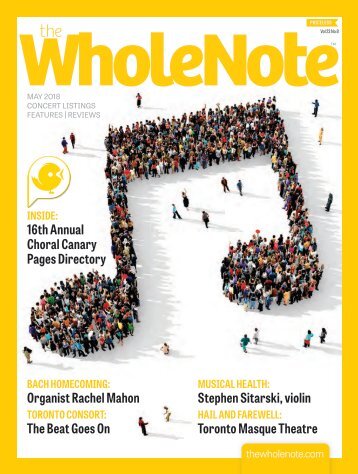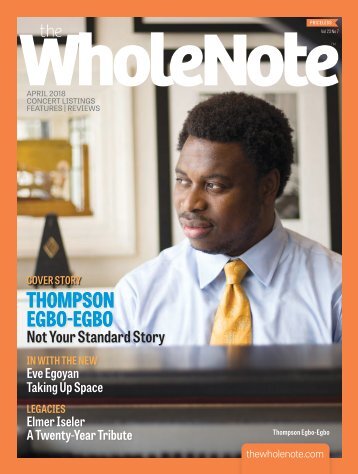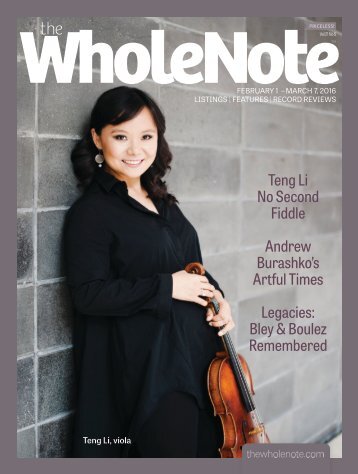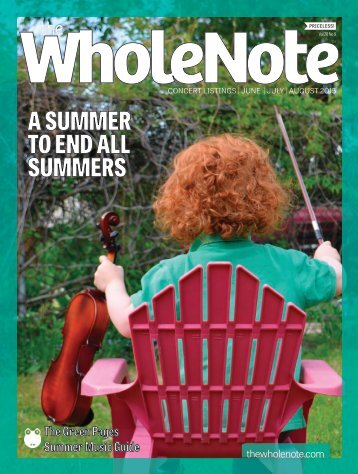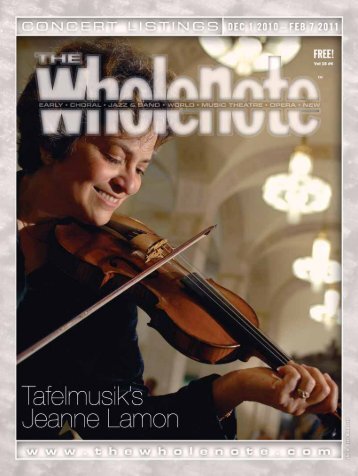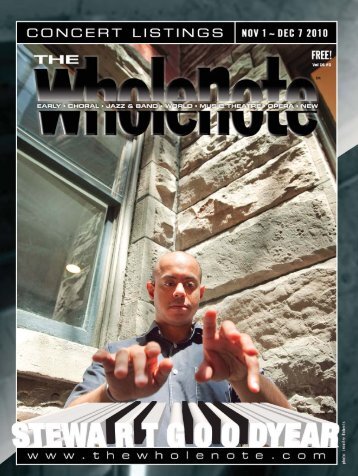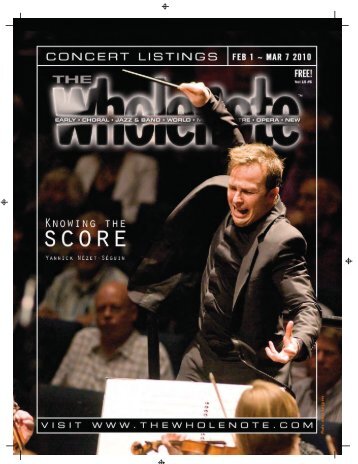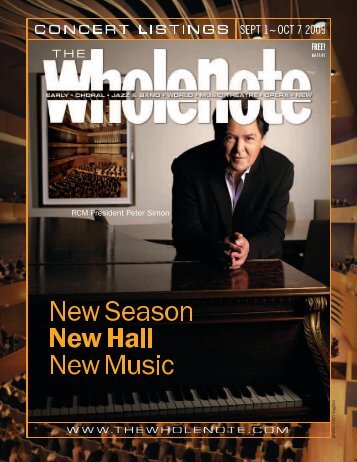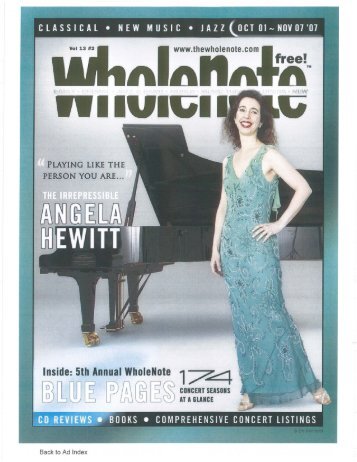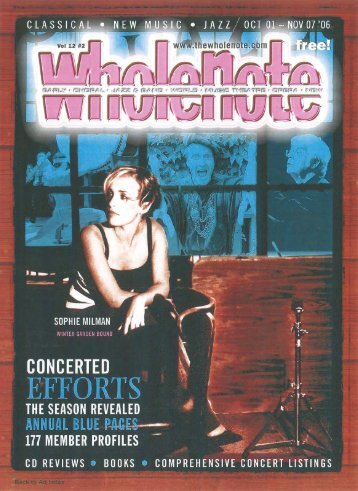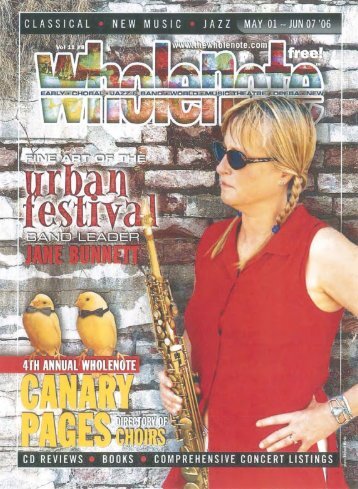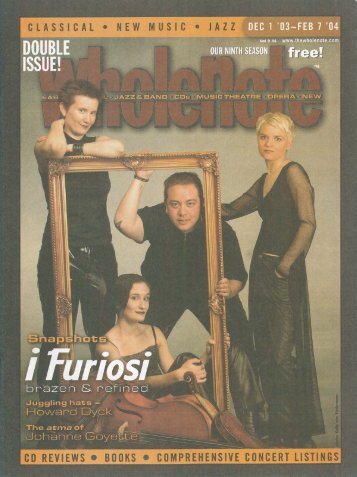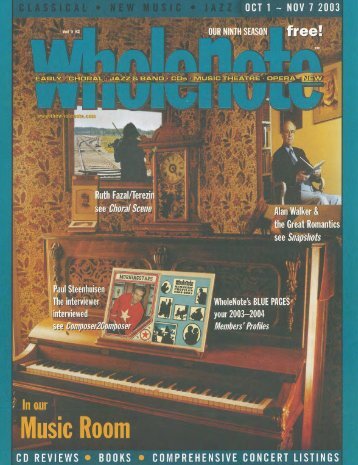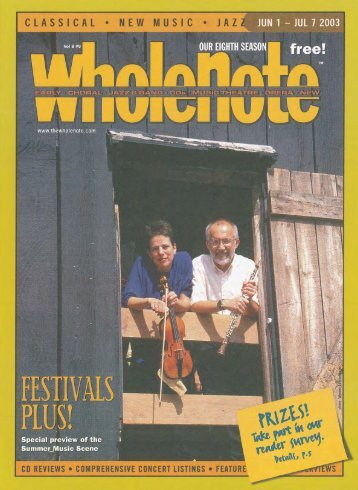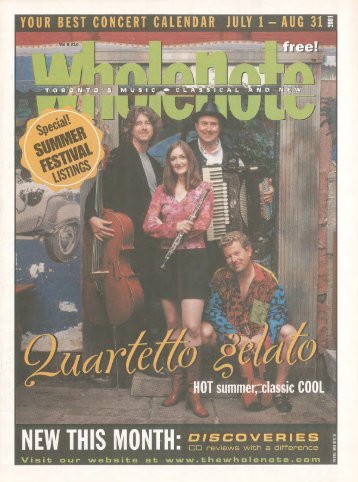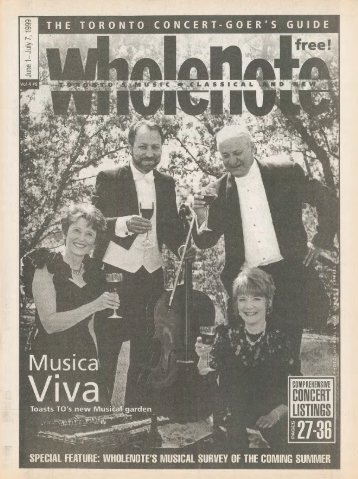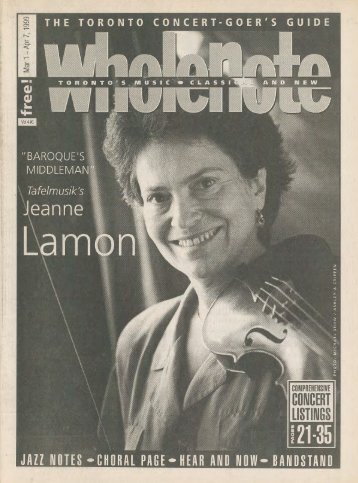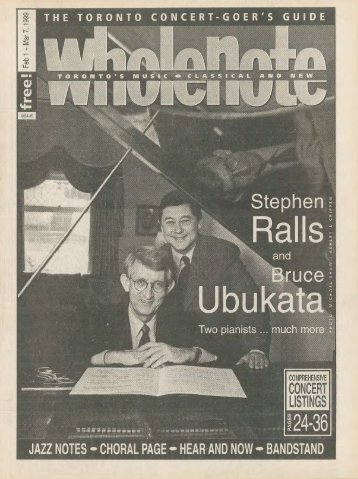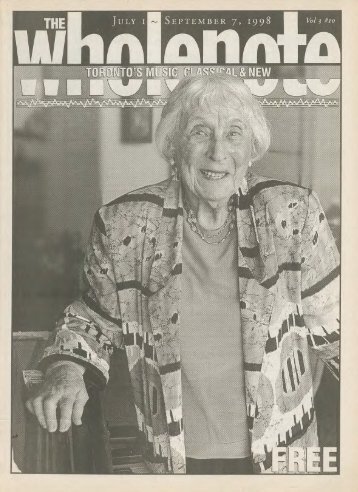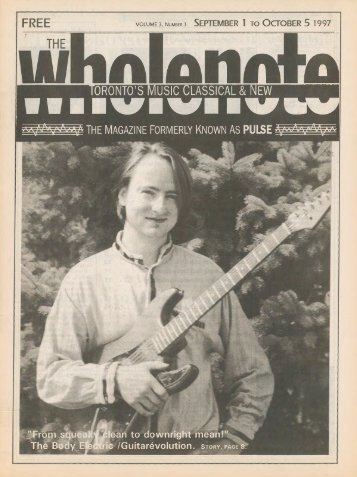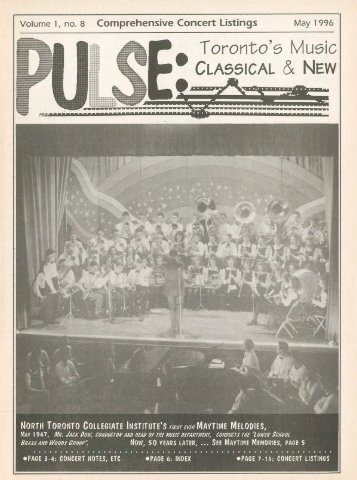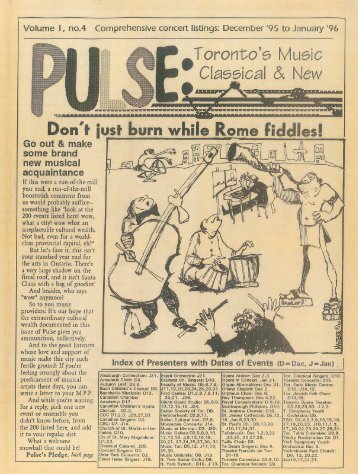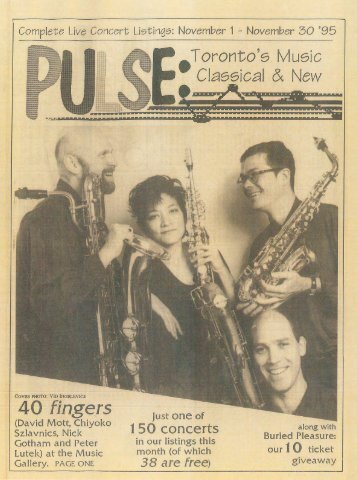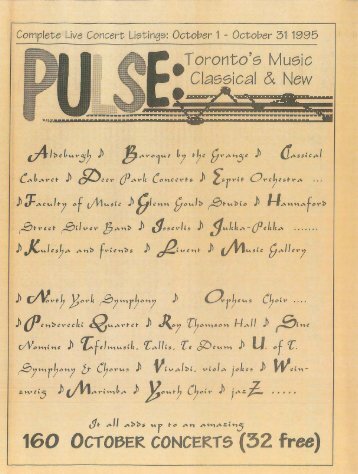Volume 19 Issue 7 - April 2014
- Text
- April
- Toronto
- Jazz
- Theatre
- Arts
- Choir
- Musical
- Symphony
- Ossington
- Bloor
it’s fortunate that
it’s fortunate that Krakauer’s equally variedmusical affiliations have encompassed JohnZorn, the Klezmatics, Itzhak Perlman andsymphony orchestras.Krakauer’s usual strategy is to retain thejaunty theme to songs like “Tradition“ fromFiddler on the Roof, as slippery clarinettrills; Jenny Scheinman’s see-sawing violinstrings and pedal reverb from Adam Rogers’guitars contrast a parallel musical identityfor the tune. These novel arrangments workwhether the psychedelic guitar excess on“Honeycomb“ from Lenny is over-emphasized,or whether on “Si Tu Vois Ma Mére“used in Midnight in Paris, Krakauer subvertsthe rote two-beat Dixieland from Jim Black’sdrums with roadhouse boogie bumps frombass and rhythm guitar as well as disco-erasound loops. At the same time while skitteringfiddle modulations, accordion slurs andstrumming guitar lines may give a piece like“Love Theme“ from Sophie’s Choice an interfacethat sounds more Palm Springs thanPoland, Krakauer’s own tone, complete withheartfelt trills and spectro-fluctuation nevermocks the music’s underlying melancholy.More to the point Krakauer’s reed skill issuch that he makes you hear some songs innew ways. Playing bass clarinet on FunnyGirl’s middle-of-road staple “People“ forinstance, his intense vibrato joined withcascading piano chords and violin runsstrengthens the melody’s poignancy withoutletting it fall into sentimentality. OverallThe Big Picture is an outstanding salute tomovies, music and movie music, whatevertheir origins.Ken WaxmanPOT POURRIThe Musical Voyages of Marco PoloMaria Farantouri; En Chordais; EnsembleConstantinople; Kyriakos KalaitzidisWorld Village WVF 479092Circles lyrics by the 14th century Iranian poetHafez are inspired by a Chinese melody. KiyaTabassian (sitar and voice) brilliantly conveysthe winding and demanding nature of MarcoPolo’s journeyings.Then the traveller reaches Uzbekistanfor perhaps the most impassioned songon the CD: Ey Dilbari Jonomin (Oh, myheart-stealing beauty) where the voices ofKalaitzidis and Nodira Permatova are allowedto express the song’s haunting quality, accompaniedonly by oud, viola and violin. All toosoon we are back on the road east with Fivesteps, a piece played on Nepalese sarangi toguide us to Mongolia, where Chandmaninutag evokes the latter’s grasslandsand streams.Finally, China. Yi Zu Wu Qu (dance ofthe Yi nation) is a thoughtful piece for solopipa, contrasting with the complex sevenpartMusical Voyages of Marco Polo. Andthen a final inspiration. Greek legend MariaFarantouri sings Xenos (the stranger),conveying Marco Polo’s feelings of beinga stranger in a new life. Farantouri, longconsidered one of the foremost interpretersof Greek music, has lost none of her touch.Enjoy this expressive journey.Michael SchwartzMañanaAmanda MartinezIndependent (amandamartinez.ca)Latina songstress,broadcaster,actor and composer/lyricist, AmandaMartinez’ latest CD,Mañana is a zestymusical “Caldo” – brilliantlyand authenticallyproduced by Javier Limon and dGeorgeSeara. The 12 tracks provide a tasty banquetof original, Mexican and Tejano-inspiredcompositions, served up with healthy dosesof a tropically infused blend of the tart andthe sweet. On Mañana, Martinez wearsseveral hats – as artist, composer and lyricist,and the recording itself is a tribute to themusical influences of her beloved Mexico,imbued with contemporary and traditionalmotifs as well as stylish arrangements andsuperb musicianship and vocals from herfine ensemble.Martinez’ co-creators include the talentedbassist Drew Birston, singer Fernando Osorio,skilled guitarist Kevin Laliberte, Javier Limón(arranger and co-producer) and writers ElstenTorres, Daniel Martinez Velasco, Claudia Brantand Nana Maluca. All songs on Mañana aresung in Spanish, with the exception of three:“Frozen” – featuring Martinez’ intriguingnarrative lyric, “Le Chemin,” rendered inflawless French, and the youthfully romanticand salsa-rific, “Let’s Dance,” sung in English.Martinez’ clairent, musical tone melded withher sibilant, colonial Spanish is a delightfultreat for the ear, the heart and the soul. Herpure and supple voice is capable of communicatinga range of potent emotions – from thedeeply sensual to heartbreaking innocence.Superb tracks include the optimistic andtraditionally arranged “Esperanza Viva” – afine composition by Brant and Maluca; thelilting Dias Invisibles, which is an inspiredcollaboration between Martinez and guitaristLaliberte replete with some delightful BurtBacharach-ish horn lines. Also of particularbeauty is Martinez and Limón’s “Ahora site Canto” – a tender and evocative ballad,laden with lush and almost mystical, Iberianmodalities as well as thoroughly stunningviolin work by Osvaldo Rodriguez.Lesley Mitchell-ClarkeConcert note: Amanda Martinez launchesMañana with a concert at the Winter GardenTheatre on April 5.Italy to China inMarco Polo’s footsteps,interpretedstage by stage bylocal music, inspiredKyriakos Kalaitzidisto coordinate and tocompose a virtualjourney along the Silk Road.Early music enthusiasts will get theireye (or ear) drawn in with the well-knownLamento di Tristano which weaves itssedate course by bringing together WesternEuropean and Middle-Eastern instruments.This same combination forms Kalaitzidis’choice for one of his own compositions,the equally sedate Marco’s Dream. What acontrast then with his second composition,Gallop, which conjures up Marco Polo confidentlyand swiftly crossing the Silk Road onhis mission.As Marco Polo moves eastward the musicescorts him, as its style changes. In MigrantsMore DISCoveries at thewholenote.com with the following additional newreviews:To read how Dutch pianist Michiel Braam, the Dutch-American group The Whammies andthe French-German band Die Hochstapler reinterpret standards see the continuation of KenWaxman’s Something in the Air at thewholenote.com.Strings Attached also continues at thewholenote.com with two other terrific Hyperion CDsfeaturing Steven Isserlis and Robert Levin (Beethoven) and the Leonore Piano Trio (Arensky),plus a disc by violinist Ning Feng (Bruch and Tchaikovsky) and the second instalment of stringquartets by Rued Langgaard (Nightingale Quartet).76 | April 1 – May 7, 2014 thewholenote.com
Vancouver-based guitarist/composer Bill Coon hasspent quite a bit of timeworking with singers like DenzalSinclaire and Kate Hammett-Vaughan. They clearly hear Coon’srare ability to provide optimumframing for a melody. His lyrical l giftis much in evidence on Scudder’sGroove (Pagetown 006, billcoon.com),a magically tunefulset in which standards andCoon compositions alike seemto bubble up through thewarm, glassy sound of hisguitar. His trio rendering ofMy Funny Valentine is a modelof jazz ballad playing. Coongets solid support from bassistDarren Radtke and drummerDave Robbins, while the lateRoss Taggart on tenor saxophoneis a perfect partner. Taggartswings magnificently on theopening version of Lady Be Good and Coon’sThelonious Monk-inspired But I’m Glad YouDid, while his playing on Ballad for Someoneand the title track resonates with the samedepth of feeling that Coon brings to them.Coon’s special contribution to Canadianjazz singing is immediately apparent on LauraCrema’s Fotografia (lauracrema.com), as theVancouver singer opens her fourth CD withjust Coon’s guitar momentarily embracingher voice. That initial lack of adornment isemblematic of Crema’s work: she favourssubstance over decoration, eschewing bothaffectation and surface perfection in favourof direct, emotional renderings of her disparateand imaginative material, includingEllington’s Azure, a duet with Coon; JohnLennon’s Beautiful Boy, a vocal duet withbassist Adam Thomas; a compelling Wild Isthe Wind with pianist Sharon Minemoto;three songs by Antonio Carlos Jobim; and twooriginals by Crema and Minemoto. SomehowCrema ties them together, along with aconcluding version of Kurt Weill and MaxwellAnderson’s Lost in the Stars that leaves thebest possible impression, its dreamlike ambienceshot through with emotional grit.Composer/trombonist Jeff Presslaff left hisnative New York City for Manitoba in 1997,but he’s found an intriguing way to mergethe two locales in The Complete Rebirth ofthe Cool (Cellar Live CL071113 cellarlive.com). In 1949 Miles Davis was at the centreof a group developing fresh concepts in jazzorchestration, among them Gil Evans, GerryMulligan and John Lewis. The result wasDavis’ Nonet, a group that included Frenchhorn and tuba, as well as likelier jazz instruments.Collected on an LP in 1957, the group’sSTUART BROOMER78s were dubbed The Birthof the Cool. Presslaffhas assembled a groupinManitoba withidentical instrumentationand commissionedcompositionsinspired by the originalNonet’s works. It’sgenerally true to thesubtle textures andharmonies of the originals,though at timesit turns ponderous.Trumpeter DeanMcNeill provides thelivelier What Fourth,while Jon Stevens’brooding NovemberNight explores morecontemporary sonics.That early MilesDavis project was alsoameeting ground forsome of the key figures in the third streammovement that would seek to fuse elementsof jazz and classical music, including Evans,Lewis and Gunther Schuller, the Nonet’sFrench horn player. “Third stream” mayonly be cited as an historical category thesedays, but it’s a pervasive methodology formany musicians. Greg de Denus is a youngToronto pianist whose background includesstudies with such distinguished musiciansas Don Thompson, Fred Hersch andDave Douglas. The quality of the instructionis more apparent than specific influencesin Solo Piano, Live at Gallery 345 (PetMantis Records PMR009 petmantisrecords.com), which has de Denus working througha program in which composition and improvisationare often indistinguishable. There’sa rhapsodic sweep to much of this music, deDenus’ pyrotechnics often tending towardchromatic fantasia on pieces like PocketJacks. It even touches Steve Swallow’s FallingGrace and Thelonious Monk’s In Walked Bud,which has as much Rachmaninov as BudPowell. De Denus is true to the tradition ofFrench Impressionism in jazz, summoningup the spirit of Duke Ellington in Alter Ego.When de Denus slows down, he produces theelusive Folksing, a study in sonoritythat’s as beautiful as it is original.The influence of classicalmodels is also apparent in muchof the work of clarinetist/saxophonistPeter Van Huffel, theKingston, Ontario native whoserecent residences include NewYork and Berlin (Van Huffelalso hasa duo with Greg de Denus). Thegroup House of Mirrors continuesVan Huffel’s partnership withsinger Sophie Tassignon, withpianist Julie Sassoon and bassistMiles Perkin (originally fromWinnipeg) completing the group onAct One (Wismart W 105wismart.de). The piece is a long suitewith both composed and improvisedmaterials, summoning up everythingfrom medieval song to jazz,School of Vienna abstraction andEuropean free improvisation. It’sheld together by sheer virtuosityand the focal point of Tassignon’s mercurialvoice.Saxophonist/clarinetist Anna Webber isanother Canadian expatriate with similarmusical breadth and co-ordinates: originallyfrom British Columbia, she has residedsuccessively in Berlin and Brooklyn. She hasan absolute gem as a memento of her Berlinstay, Percussive Mechanics (Pirouet PIT3069, pirouet.com). Webber leads a septetof mostly German percussionists in a suiteof her compositions that seems to simultaneouslyconnect to African music, New Yorkminimalism and the late serialism of Boulez’Le marteau sans maître. There’s real powerhere, with a sense of mystery and essentialcoherence arising from the evolving rhythmiclanguage and its ability to absorb certainkinds of almost-random fractures. Webberthe tenor soloist comes to the fore on the titletrack, rising over the underlying patternswith expansive detailed runs delivered withmachine-gun precision.Mid-Month. Every Month.Sign up for HalfTonesThe WholeNote mid-month e-letter.Scan the code or go to thewholenote.com/halftones toregister. You can also follow @TheWholeNote on twitter or‘Like’ The WholeNote at facebook.com/LikeTheWholeNote.thewholenote.com April 1 – May 7, 2014 | 77
- Page 1 and 2:
PRICELESS!Vol 19 No 7CONCERT LISTIN
- Page 3:
Pax Christi ChoralePassionwith True
- Page 6 and 7:
FOR OPENERS | DAVID PERLMANEven wit
- Page 8 and 9:
Johannes Debus/Pre-COCWhere were yo
- Page 10 and 11:
We haven’t had our epicfight yet
- Page 12 and 13:
together. And because of the proxim
- Page 14 and 15:
a clear Canadian Brass identity to
- Page 16 and 17:
Nariné Ananikyan,soloist for the N
- Page 18 and 19:
immediacy that is almost unbearable
- Page 20 and 21:
Toronto Children’s ChorusYouth an
- Page 22 and 23:
among others.On April 12 Islington
- Page 24 and 25:
Canadian Institute for Czech Music
- Page 26 and 27: udget available to the king of Fran
- Page 28 and 29: Rick Sacksplays MalletKatinstrument
- Page 30 and 31: In Canada several of gamelan music
- Page 32 and 33: From the late 1800s there was music
- Page 34 and 35: The WholeNote listings are arranged
- Page 36 and 37: ; (sr); (st).● 7:30: Yor
- Page 38 and 39: Hammerstein, libretto; book by Howa
- Page 40 and 41: Ainsworth, tenor; Nathaniel Watson,
- Page 42 and 43: W. 416-408-0208. -. 7:00: Pre
- Page 44 and 45: Markham. 905-305-7469. -. 7:1
- Page 46 and 47: Arnie Naiman; Chris Quinn. 22 Churc
- Page 48 and 49: Concert Hall, 273 Bloor St. W. 416-
- Page 50 and 51: ● 7:30: Annex Singers. The Road H
- Page 52 and 53: Barrie. 705-726-1181. Free.● 7:30
- Page 54 and 55: Beat by Beat | In the ClubsCONTINUE
- Page 56 and 57: Every Mon 10pm Open Mic. Apr 10 9:3
- Page 58 and 59: Wurlitzer Theatre Organ. Casa Loma,
- Page 60 and 61: WE ARE ALL MUSIC’S CHILDRENWHO IS
- Page 62 and 63: ORANGE PAGESWelcome to The WholeNot
- Page 64 and 65: ORANGE PAGESbeautiful tone in a fri
- Page 66 and 67: ORANGE PAGES● MNjcc Suzuki Music
- Page 68 and 69: Adam WeinmannOboe/PianoAlexander Ka
- Page 70 and 71: Quite a few years ago, franklyalmos
- Page 72 and 73: choices in this production, the mus
- Page 74 and 75: Beethoven - Symphonies 1 & 7Orchest
- Page 78 and 79: Old Wine, New Bottles | Fine Old Re
- Page 80: PETER SELLARS DIRECTSHANDEL“An op
Inappropriate
Loading...
Mail this publication
Loading...
Embed
Loading...
























